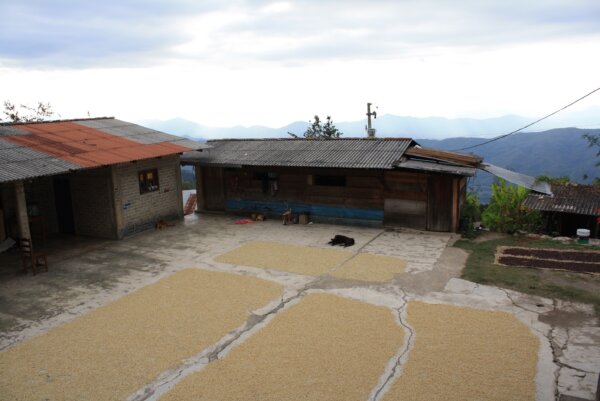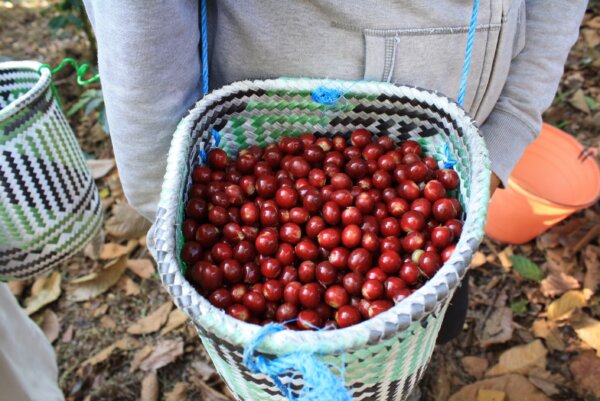About El Portillo

 San Vicente Yogondoy is a lush, densely-forested community in the Sierra Sur region of Oaxaca’s Pochutla district. It harbors steep slopes where coffee grows under a thick canopy of native shade facing the Pacific Ocean to the south. It receives very distinct rainy and dry seasons with cooling Pacific breezes.
San Vicente Yogondoy is a lush, densely-forested community in the Sierra Sur region of Oaxaca’s Pochutla district. It harbors steep slopes where coffee grows under a thick canopy of native shade facing the Pacific Ocean to the south. It receives very distinct rainy and dry seasons with cooling Pacific breezes.
Getting to San Vicente Yogondoy from Oaxaca takes approximately 5 hours via road. That road is in good condition, so the real challenge is getting from the town of Yogondoy out to the farms. Unlike many other producing areas where producers live on their farms, Yogondoy’s producers usually live in the central town and their farms are far away.
Jose Monjaraz Alonso’s farm El Portillo spans 3.5 hectares in the El Portillo community, after which it’s named. Reaching El Portillo can take about 2 hours on foot from the city. During harvest, Jose and his family stay in temporary housing on the farm, moving their coffee by mule or on foot to the city over several trips.
Because the farm is so remote and steep, cherries are often left overnight after harvest before they enter processing. This means they experience an extended time between picking and depulping—a de facto extended fermentation that absolutely adds to their complexity.
Jose then moves the coffee to the family washing station at his house, where he ferments it in wood tanks for 48 hours, then dries it for 4 to 5 days on patios.
El Portillo usually keeps a distance of 2 meters between rows and 1.5 meters between seedlings. Between each row, Jose places a plant that serves to separate the rows and keep the coffee trees apart. Yogondoy has a high level of plant diversity on the coffee farms compared to other coffee-growing areas. Jose uses native trees such as ice cream bean trees and avocado to shade the coffee trees. These trees provide not only shade, but also various benefits such as food, ornamentation, medicine, construction materials, and water collection.
Jose is a very young producer from the area, born in 1993. He has a wife and 4 children. Their farm is only 10 minutes away from the nearest road. He usually transports his coffee on mules that he lends to his family and neighbors. If harvest is particularly abundant, Jose usually hires local harvesters from the area. Jose’s speaks Spanish and Zapoteco.
Yogondoy’s indigenous Zapotec traditions and language are alive and well. In Zapotec, Yogondoy means “River of Bees,” and many local farmers keep beehives for honey and pollination alongside their coffee. Many of the farmers in this group have younger coffee trees that were planted in the last 5 years and continue the tradition of maintaining almost 100% of the Pluma variety, a local mutation of Typica that has grown here for over 80 years. It thrives in these conditions, soil, and climate, producing spectacular cup quality. Many of the farmers are also under 30 years old, an encouraging fact showing that coffee has a future here. However, a percentage of young people are also migrating to the capital in search of better opportunities.
Another tradition still very present in the Zapotec community in the area is the practice of Tequio (a word from the Nahuatl language that means work or tribute), a practice of communal workshare that comes into play during harvest and in off-season renovations.
Yogondoy is one of the few communities in which we see a year on year increase in both yield and quality. The producers here have invested a lot in their crops for 8 years, leading to production between 1000-2000 kg per hectare of dry parchment—nearly double that of many other Mexican coffee-growing areas. The incredibly lush green environment and the Pluma variety come together in Yogondoy to yield something truly unique and special that only Oaxaca can offer.
One of the biggest challenges here is labor costs that have quadrupled over the last 2 years and an important component in the area is that our presence as ready and enthusiastic buyers here means we are invested in these coffees continuing to be worth it for producers, since their existence enriches the entire coffee-drinking world. They’re valuable in a very different way than the coffees we’re bringing in from Veracruz. We really don’t see other buyers here with any kind of consistency at a similar scale, and we see immense importance to supporting these communities’ work. Which is to say, if you see cheap coffee out of Oaxaca it’s either not really from Oaxaca or relies on overtly exploitative practices, especially this year as labor costs continue to climb. These coffees are absolutely worth it, and we anticipate a continued growing recognition of that worth with each new season.
Our work in this area started off with a very small group, who, sick of selling their coffee for subpar prices to coyotes and a single cooperative that was dominant at the time, sought a more stable and profitable dynamic. We tried our first samples here almost a decade ago, and since then we’ve built a strong bond with more and more of Yogondoy’s producers, helping them access better prices and more competitive markets. The relationship is built on a foundation of trust and traceability.



 San Vicente Yogondoy is a lush, densely-forested community in the Sierra Sur region of Oaxaca’s Pochutla district. It harbors steep slopes where coffee grows under a thick canopy of native shade facing the Pacific Ocean to the south. It receives very distinct rainy and dry seasons with cooling Pacific breezes.
San Vicente Yogondoy is a lush, densely-forested community in the Sierra Sur region of Oaxaca’s Pochutla district. It harbors steep slopes where coffee grows under a thick canopy of native shade facing the Pacific Ocean to the south. It receives very distinct rainy and dry seasons with cooling Pacific breezes.
